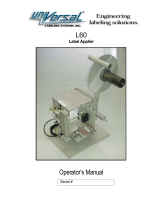
3
1 Introduction ............................................................................................................................................ 4
1.1 Instructions ...............................................................................................................................................4
1.2 Intended Use ............................................................................................................................................4
1.3 Safety Instructions ....................................................................................................................................4
1.4 Safety Markings .......................................................................................................................................5
1.5 Environment .............................................................................................................................................5
2 Product Description ...............................................................................................................................6
2.1 Important Features ...................................................................................................................................6
2.2 Technical Data ..........................................................................................................................................6
2.3 Overview .................................................................................................................................................. 7
2.4 Contents of Delivery .................................................................................................................................9
3 Operation .............................................................................................................................................. 10
3.1 Standard Operation ................................................................................................................................10
3.2 Cleaning .................................................................................................................................................10
4 Error Messages .................................................................................................................................... 12
4.1 Error Messages of the Printer ................................................................................................................ 12
4.2 Error Messages of the Applicator ...........................................................................................................12
5 Licences ................................................................................................................................................13
5.1 Declaration of Incorporation ...................................................................................................................13
5.2 EU Declaration of Conformity .................................................................................................................14
6 Installation ............................................................................................................................................ 15
6.1 Factory Defaults .....................................................................................................................................15
6.2 Tools .......................................................................................................................................................16
6.3 Mounting the applicator ..........................................................................................................................16
6.4 Transport lock.........................................................................................................................................17
6.5 Mounting the Pad ...................................................................................................................................18
6.6 Mounting the Blow Tube .........................................................................................................................18
6.7 Connecting the Compressed Air ............................................................................................................19
7 Adjustments .........................................................................................................................................20
7.1 Pad Adjustments .................................................................................................................................... 20
7.2 Adjusting the Swing Area of the Pad ......................................................................................................21
7.3 Stopper for Operation Mode "Blow on" .................................................................................................. 22
7.4 Adjusting the Sensors of the Swing Drive ..............................................................................................23
7.5 Adjusting the Speed of the Swing Drive .................................................................................................23
7.6 Sensors on Cylinder Z ............................................................................................................................24
7.7 Lift Speed of Cylinder Z ..........................................................................................................................25
7.8 Adjusting the pressure reduction valve .................................................................................................. 25
7.9 Vacuum Adjustments ..............................................................................................................................26
7.10 Blow Tube (Support Air) Adjustments .....................................................................................................27
8 Conguration
........................................................................................................................................29
8.1 Method for Changing the Printer Setup ..................................................................................................29
8.2 Quick Mode for Setting the Delay Times ................................................................................................29
8.3 CongurationParametersoftheApplicator ...........................................................................................30
8.4 Setting the Peel Position ........................................................................................................................31
8.5 Activation of Peel-off Mode .................................................................................................................... 31
9 Operation .............................................................................................................................................. 32
9.1 Test Mode without Print Job ...................................................................................................................32
9.2 Test Mode with Print Job ........................................................................................................................32
10 Spare Parts ........................................................................................................................................... 33
10.1 Retainer Assembly ................................................................................................................................. 33
10.2 Pneumatics Retainer Assembly .............................................................................................................34
10.3 Electronics Retainer Assembly ...............................................................................................................35
10.4 Swing Drive / Cylinder Assembly ...........................................................................................................36
10.5 Pad Assembly ........................................................................................................................................37
11 Drawings ...............................................................................................................................................38
11.1 Block Diagram Type 3214 ......................................................................................................................38
11.2 Pneumatic Drawing Type 3214 ............................................................................................................. 39
12 Index ......................................................................................................................................................40
Table of Contents




















